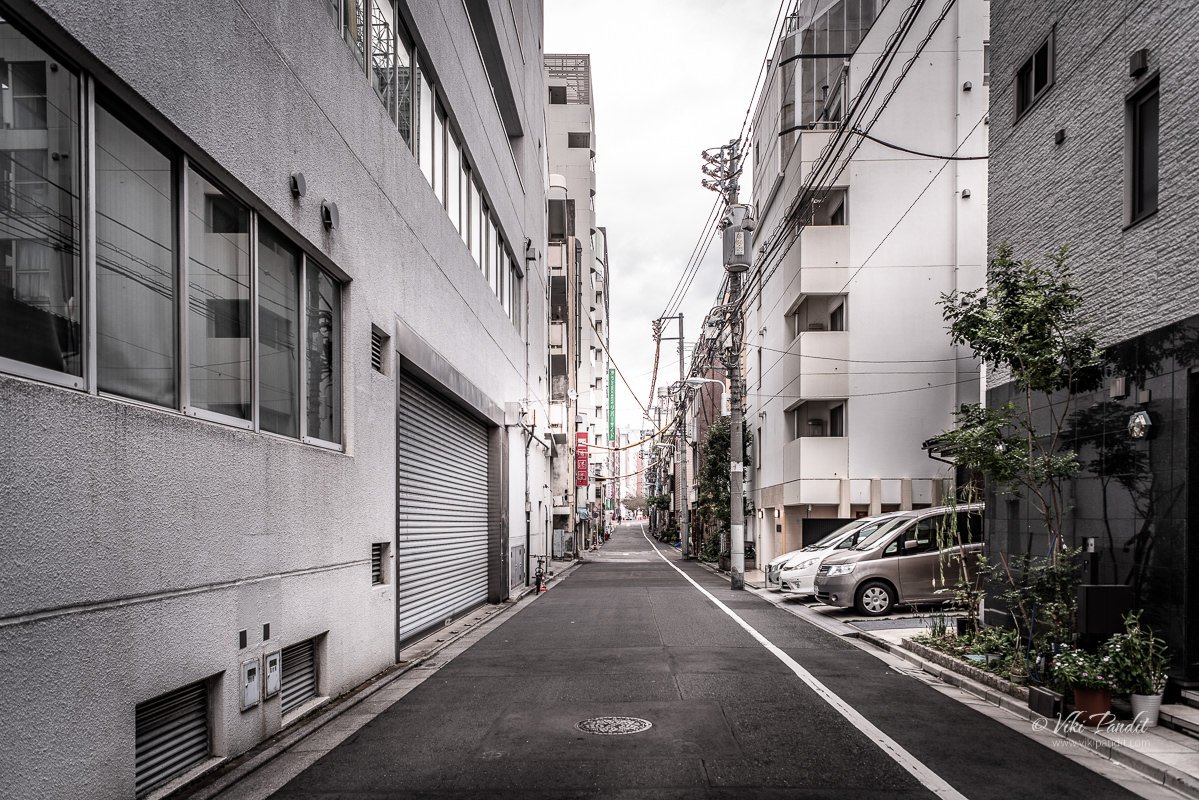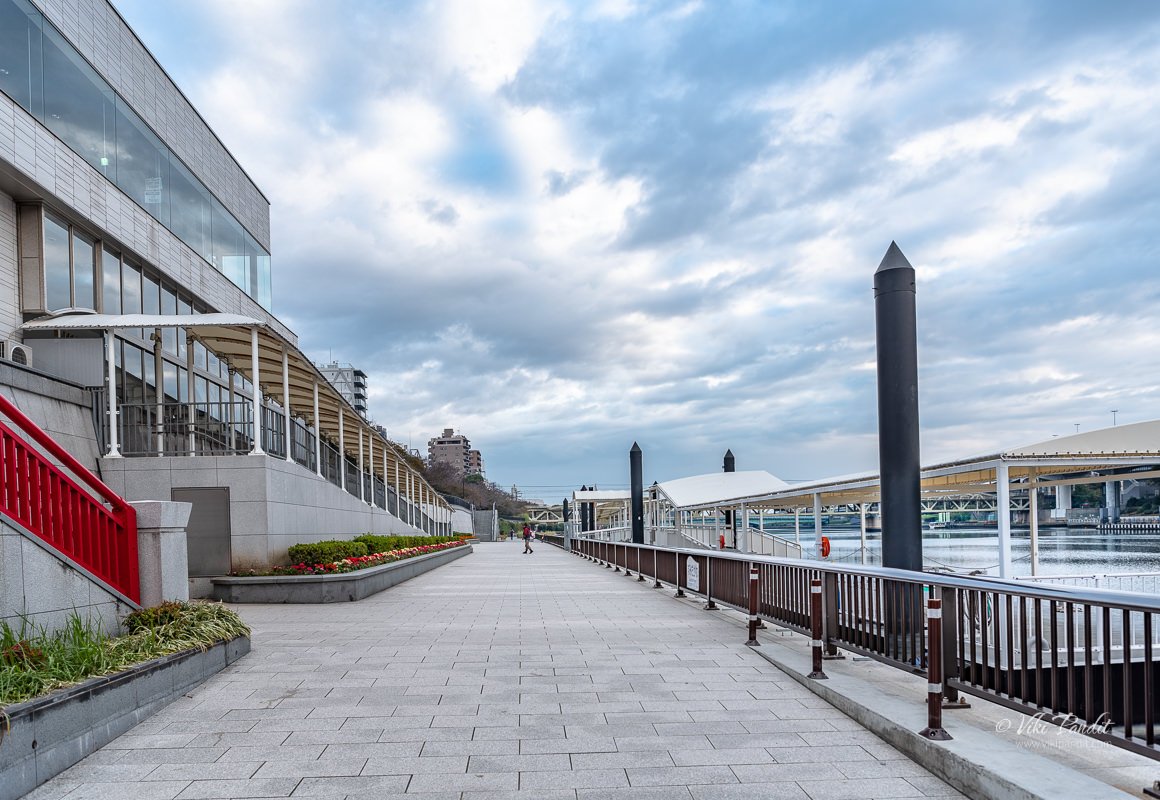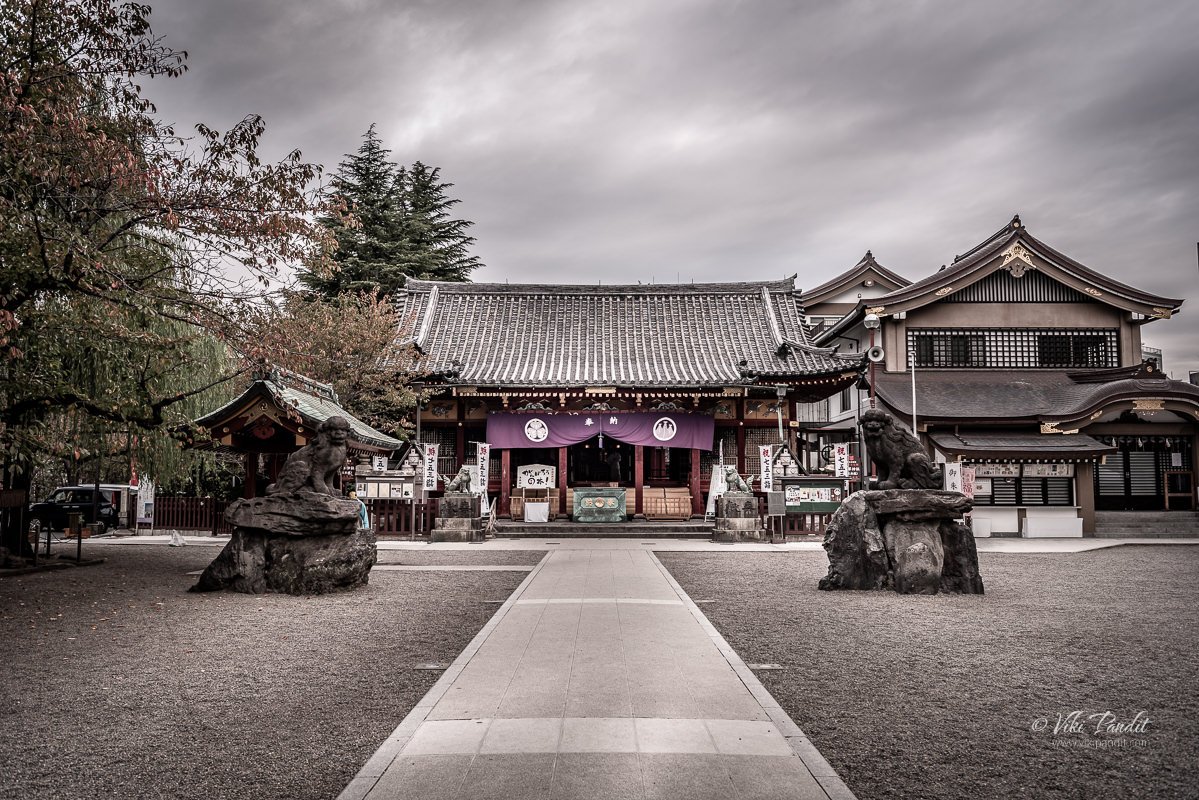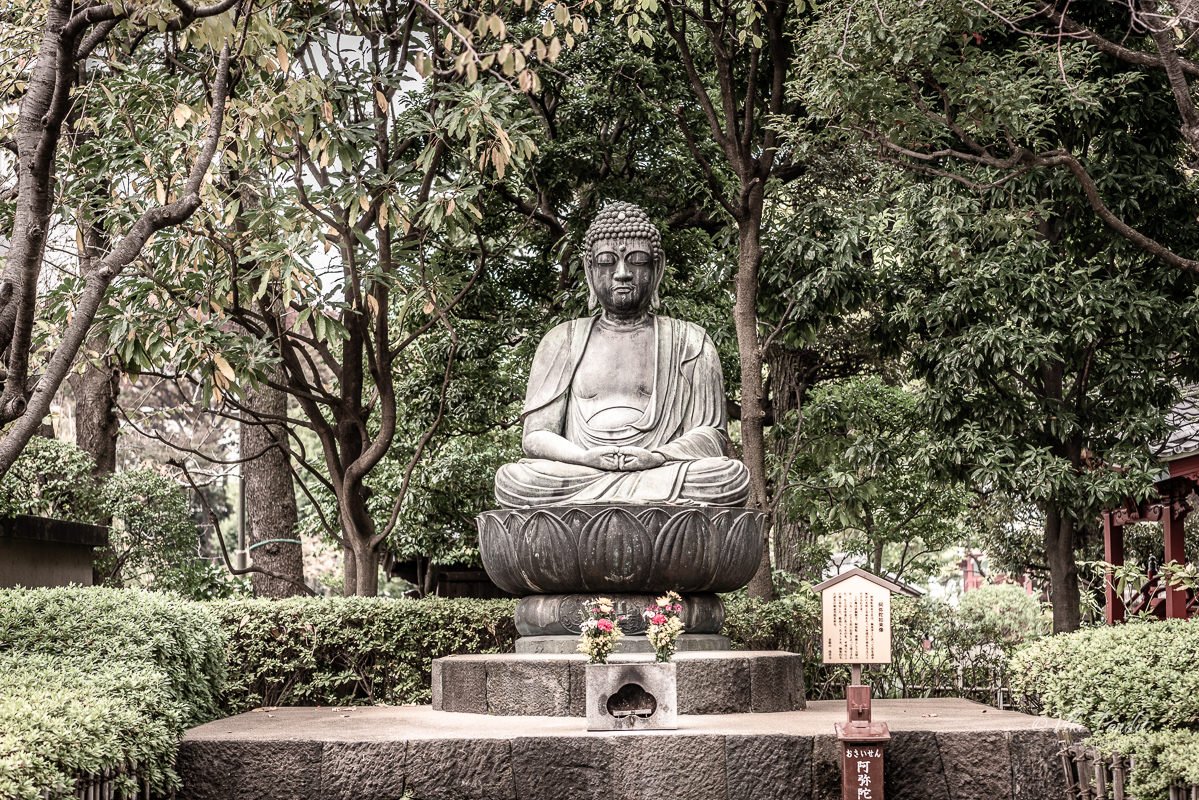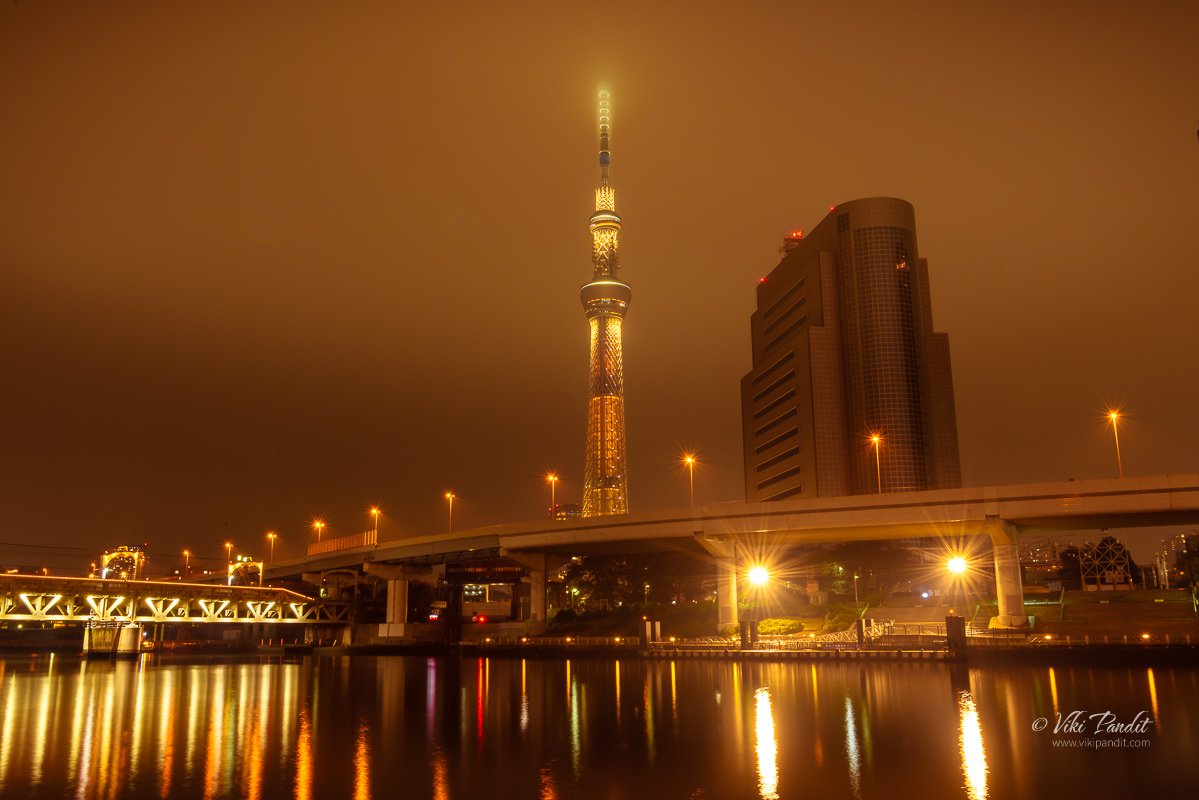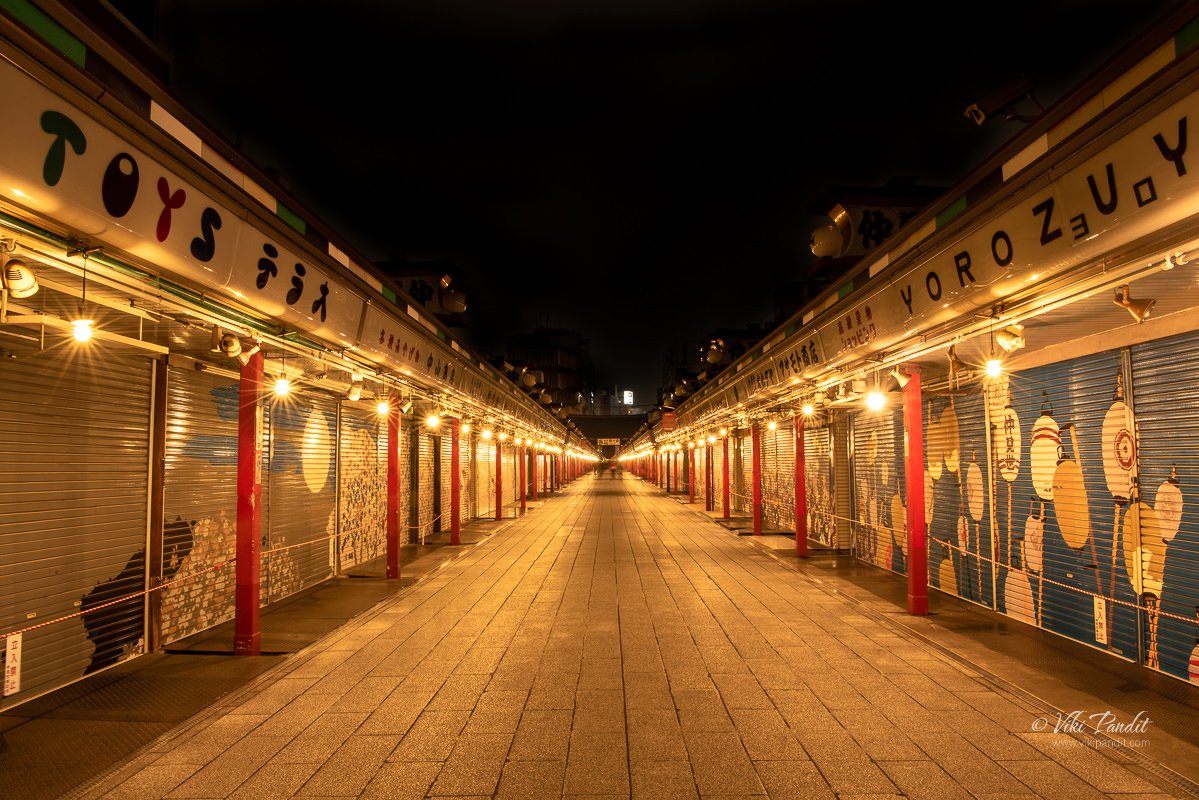Sensō-ji is an ancient Buddhist temple located in Asakusa district of Tokyo, Japan. It is Tokyo’s oldest temple, and one of its most significant. It is a very busy place during daytime so I decided to escape the crowd by visiting early at dawn and then returning back late at night.
We were staying at APA Hotel Asakusa-Kuramae. It is just a couple of minutes walk away from the Kuramae Station on the Toei Oedo Subway Line. I had intentionally reserved this hotel as it is at a walk-able distance from the historic temple. I left the hotel at around 6:30 am. The skies were a saddening, dull gray as I made my way along the quiet alleys.
Because the hotel was near the Sumida river, I choose to walk along the banks towards the heritage temple. Along the way, helping myself to some pictures. The picture below is a shot of the Azuma Bridge with the Asahi Beer Headquarter Building in the background.
You can cross the Azuma bridge from above, but I chose to go under a small dark tunnel. This tunnel is mainly used by joggers, so they don’t have to climb the stairs to cross over to the other side of the road above.
Across the tunnel, I found myself in the Sumida Park area. On the right there is a small dock for ferries. On your left, you can find the Tokyo Cruise Ship Asakusa office. If you are looking for a cruise around Tokyo on the Sumida River, this would be the place to go.
From here I took a left turn towards Senso-ji. From the Azuma bridge you can directly head for the temple, that is the more correct way, that leads directly to the temple main gate and then the temple, but I love to wander about a little.
The Nitenmon Gate
Coming from the river side, the first structure I encountered was the Nitenmon Gate, located on the east side of the Main Hall. Nitenmon in Japanese means “the gate of two ten”. It is named so because of the two protective Buddhist deities (known as ten) that can be seen on its left and right side.
The deities are called Zochoten and Jikokuten respectively. The original statues were destroyed in 19th century. Since then, substitute statues from the Ueno Kaneiji stands there. This gate leads directly to main altar of Senso-ji. It was originally built in 1618 CE and has been named an Important Cultural Property.
Asakusa Shrine
From the gate, towards my right I could see the Asakusa Shrine. I went in and paid my respects. The Asakusa jinja is a Shinto shrine also referred to as Sanja-sama (Shrine of the Three gods). It’s modest appearance belies its historical and cultural significance. The shrine honors the spirits (kami) of the three men – the Hinokuma brothers and Chief Hajino, who founded Sensō-ji.
After taking a few pictures, I made my way towards the main hall of the Senso-ji.
History of Senso-ji
According to legend, Senso-ji Temple was said to have been created when a statuette of Kannon was fished out of the nearby Sumida River by two local fishermen brothers – Hinokuma Hamanari and Hinokuma Takenari in the year 628 CE. It is a mystery as to who carved the statue, or how it had come to be floating in the waters of Sumida, but everyone considered the discovery of the statue to be a miraculous event.
News was sent to the then capital of Japan, which was in Nara, a city to the south of Kyoto. Nara was at that time under the reign of Empress Suiko. She was a very devout Buddhist and is credited with establishing many of the oldest temples and monasteries in Nara. When she heard the story of the two fishermen and the statue of Kannon, she ordered that a temple be built to house the statue.
For those who don’t know, Tokyo was just a small village at that time. The chief of the village, Hajino Nakamoto was greatly moved by the presence of the idol and he decided to remodel his own house into a small temple where the villagers could worship the goddess of mercy. The statue was consecrated during the Kamakura period, around the year 645 CE, which makes the temple the oldest temple in the capital.
Centuries later, Senso-ji became associated with the Tendai school of Buddhism. This Mahayana Buddhist tradition brought over from China in the 8th century became the dominant form of Buddhism among Japan’s upper classes for many centuries.
Although most of the original temple buildings were destroyed by US bombs during World War II, the structures was rebuilt soon afterwards in 1950.
Actually, Senso-ji’s full name is “Kinryū-zan Sensō-ji” , Kinryu-zan meaning “The mountain of the golden Dragon” .
The Main Temple Compound
It was quiet early but a steady stream of visitors were already coming in to pay their respects. The Main hall is the largest structure in the complex. In front of the main hall lies a large incense cauldron. You can light some incense sticks there if you prefer. Before entering the hall you can also indulge in some harmless fun by buying the Omikuji (paper fortunes) that costs 100 yen. But even if you unfortunately draw bad luck, don’t be discouraged, just tie them around a designated place nearby and hope for a better one next time, fingers crossed 🙂 A lot of Omikuji will already be hanging nearby like white flowers, so you can’t miss it.
The Hondo (Main Hall)
The Hondo or Main Hall houses the Kannon statue. The statue is kept deep inside the hall to keep it safe from pollutant degradation. The Hondo Hall is a national treasure and was originally built in 942 CE. It was later rebuilt by the third Shogun, Tokugawa Iemitsu. The current building dates from 1958. Photography is not allowed inside the hall.
Inside of the hall was rather cold, presumably because of lack of any sunlight inside. I paid my respects and walked back out. From the top of the stairs I took this photo of the Hozomon Gate.
I wandered around the main hall taking a few shots. With the thick cloud cover, the day was photogenically extremely boring. I have tried to spruce them up in Lightroom to bring some energy into them.
Five Storey Pagoda
While walking around the Hondo, I strayed into a small rock garden. From here I got a better shot of the Pagoda.
The Five Story Pagoda (Goju-no-Tou), which is said to contain some of the ashes of Buddha. The Pagoda is approximately 53 meters high and is especially picturesque at night when all lit up. The original structure was built in 942 CE. It was later reconstructed in 1973. It is a national treasure and the second highest pagoda in Japan.
In the garden on the right of the Hondo, there is a small landscaped garden. In the garden you can find a hexagonal temple. I am not too sure about its history but the small wooden structure tucked away in the north-west corner of the temple grounds was built way back in 1618.
It was originally built on top of a well, but was slightly moved from its original location in 1994. The inner structure follows an umbrella-like wooden structure called ougitaruki. The Higiri Jizō-son is enshrined in the small wooden structure, which translates as “Time-bound Ksitigarbha-bodhisattva.”
Directly opposite to the hexagonal temple lies a seated bronze Buddha. Talking of seated Buddha’s, if you are touring Japan, you must not miss these four:
The Hozomon Gate
After leaving the garden, I walked towards the Hozomon Gate. The Hozomon Gate is the gateway to the inner complex of Senso-ji Temple and the temple’s inner gate. The second floor of the Hozomon Gate houses many of Senso-ji’s treasures, including a copy of the Lotus Sutra, and the Issai-kyo scriptures.
When you are standing with your back towards the main hall, you will see the two large straw sandals hanging on the left and right of the gate. They are called waraji. These huge sandals were crafted by villagers in northern Yamagata Prefecture, and are meant to symbolize the Buddha’s power. It is believed that evil spirits will be scared off by the giant sandals. The Hozomon Gate was originally built in 942 CE. After it was destroyed during World War II, when the temple was bombed during the 10 March air raid on Tokyo, it was rebuilt in 1964.
In the same gate, from the other side you will find two statues located on either side. They are Nio Guardians, the guardian deity of Buddha, and the gate was originally known as the Niomon. You can find the pictures of the Nio guardians further down the article.
Nakamise-dōri
From the Hozomon Gate, I walked towards the main entrance gate. The two gates are connected by a long narrow corridor known as the Nakamise-dōri. It is said to have come about in the early 18th century, when neighbors of Sensō-ji were granted permission to set up shops on the approach to the temple.
In those times it was like flea market. So in May 1885 the government of Tokyo ordered all shop owners to leave to rebuild the area in an orderly fashion. In December of that same year the area was reconstructed in Western-style brick and the shop owners were allowed to come back to resume their business.
During the 1923 Great Kantō earthquake many of the shops were destroyed, then rebuilt in 1925 using concrete, only to be destroyed again during the bombings of World War II. The length of the street is approximately 250 meters and contains around 89 shops.
The Kaminarimon Gate
The Kaminarimon or Thunder Gate serves as the entrance to the Senso-ji Temple precinct. It was originally built in 942 CE by military commander Taira no Kinmasa. The gate has two protector deities, Fujin, the god of wind is on the right, and Raijin, the god of thunder is on the left.
The structure features a massive red and black paper lantern, dramatically painted to suggest thunderclouds and lightening and hence the name. The traditional lantern called chochin in Japanese is 3.9 meters high, 3.3 meters in diameter and almost 700 kg in weight. The original lantern burned down along with the Kaminarimon in the late Edo Period. It was rebuilt in 1960 and is renewed every decade with the current lantern created in November 2013.
My photo-walk of Senso-ji was done. Small crowds of tourists were beginning coming in. I spent the day casing out book stores around Tokyo. Mani needed some language books. I needed some Manga. We went to Maruzen Marunouchi Main Store, one of the biggest book store in Tokyo. It was just incredible, the sheer variety of the books they carry.
Time flies away on wings when I am surrounded by brand new books. It was late in the evening by the time we reluctantly came out of the building. By 8 pm I was back at the hotel, ready to return to the heritage site.
Night out at Senso-ji
I went down the same path as in the morning. On the way I took this shot of the bridge over the Sumida river. You can see the Skytree and the iconic Asahi Beer building in the background.
Before reaching Senso-ji, I stopped a couple of times near the Sumida river to catch the lovely Skytree. I haven’t been to the Skytree yet , but it sure is in my bucket-list.
It was late and the shops along the approach to Senso-ji were all closed. Though I couldn’t shop for souvenirs, it also meant I was not surrounded by hundreds of tourists. There are 54 shops in East side, 35 shops in West side; 89 shops in total. It gets really noisy here during daytime.
The Hozomon Gate at Night
I was at the temple by 9 pm. Even though it was late, there was a good stream of people still coming in. I waited for my moment to capture this shot of the Hozomon Gate. This is without any doubt, the most beautiful photo of Senso-ji that I have taken.
According to Oei Engi, a chronicle written around the 15th or 16th century and the only source describing the establishment of Senso-ji, Hozomon Gate (known as the Niomon Gate when it was first erected), was built in 942 by military commander Taira no Kinmasa.
Here is a close-up of the ornate lantern adorning the Hozomon Gate. The central lantern has the characters 小舟町 (Kobunacho), written on it, because this is the name of the Tokyo district that donated the lantern in 2014.
The Hōzōmon houses two guardian statues that are located on either side of the gate’s south face. These are fierce-looking protectors of the temple. In the past the gate was called the Niomon after these statues, before being renamed the Hozomon.
If you want to read more about the Nio Guardians, please read this in-depth article on the history of Nio Guardians in Japanese temples.
Red Pagoda at Night
The illuminated pagoda looked amazing in the night. Even though I was extremely tired, I was glad I decided to come back again at night.
Senso-ji Temple at Night
I was truly surprised that even at 11 pm, people were still streaming in to see the temple. I wasted many shots as people would stroll into them. What I thought would be an hours job, was taking up way too much time.
By midnight I was really frustrated as people were still coming in. I took this last shot of the temple and made my way back to the hotel.
My thoughts on Senso-ji
Japan’s most visited Buddhist temple is not one of the peaceful temples. In-fact, the temple located in Tokyo’s lively Asakusa district, holds a record of welcoming about 30 million visitors annually. I had seen pictures of the temple and that is why I chose to come during the times when I can truly enjoy it in peace.
If you visit during the day, the atmosphere of this temple is certainly not one of serenity. With its crowds, noise, and enticing shops, Senso-ji, in its own way, entertains the residents and visitors alike, offering a lively alternative to the tranquility of a Zen temple.
The reconstructions have been true to their authentic designs and the complex resembles an Edo-period site, with several imposing gates, giant lanterns, and a five-story pagoda. At the heart of the complex the main worship hall you can witness one of the oldest statue of Kannon, and if you visit in these awkward times, as I did you can see the strong faith of the local people residing nearby as they start dropping in from 5 am in the morning. In all it was a good day. Although it started quiet dull with gray clouds et al, I was able to snap some nice photos for my journal.
Thanks for reading. I look forward to your reviews and questions. If you are looking to explore more of the Kanto region, follow my story as I visit the Osanbashi Pier in Yokohama .
645 CE
Kaishō
Sensoji Temple in Asakusa is just a 15-minute train ride from Tokyo Station
Senso-ji was built to honor Kannon, the goddess of mercy.
